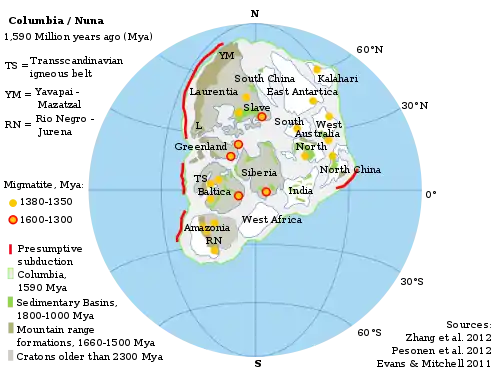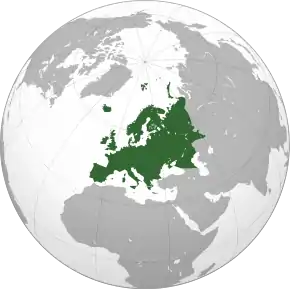Columbia (supercontinent)
Columbia, also known as Nuna and Hudsonland, was one of Earth's ancient supercontinents. It was first proposed by Rogers & Santosh 2002[1] and is thought to have existed approximately 2,500 to 1,500 million years ago in the Paleoproterozoic Era. Zhao et al. 2002[2] proposed that the assembly of the supercontinent Columbia was completed by global-scale collisional events during 2.1–1.8 Ga.

Columbia consisted of proto-cratons that made up the cores of the continents of Laurentia, Baltica, Ukrainian Shield, Amazonian Shield, Australia, and possibly Siberia, North China, and Kalaharia as well.
The evidence of Columbia's existence is based upon geological[2][3] and paleomagnetic data.[4]
Size and location
Columbia is estimated to have been approximately 12,900 km (8,000 mi) from North to South at its broadest part. The eastern coast of India was attached to western North America, with southern Australia against western Canada. In this era most of South America was rotated such that the western edge of modern-day Brazil lined up with eastern North America, forming a continental margin that extended into the southern edge of Scandinavia.[5]
Assembly
Columbia was assembled along global-scale 2.1–1.8 Ga collisional orogens and contained almost all of Earth's continental blocks.[2]
As summarized by Zhao et al. 2002:[2]
- The cratonic blocks in South America and West Africa were welded by the 2.1–2.0 Ga Transamazonian and Eburnean Orogens;
- the Kaapvaal and Zimbabwe cratons in southern Africa were collided along the c. 2.0 Ga Limpopo Belt;
- the cratonic blocks of Laurentia were sutured along the 1.9–1.8 Ga Trans-Hudson, Penokean, Taltson–Thelon, Wopmay, Ungava, Torngat, and Nagssugtoqidain Orogens;
- the Kola, Karelia, Volgo–Uralia, and Sarmatia cratons in Baltica (Eastern Europe) were joined by the 1.9–1.8 Ga Kola–Karelia, Svecofennian, Volyn-Central Russian, and Pachelma Orogens;
- the Anabar and Aldan Cratons in Siberia were connected by the 1.9–1.8 Ga Akitkan and Central Aldan Orogens;
- the East Antarctica and an unknown continental block were joined by the Transantarctic Mountains Orogen;
- the South and North Indian Blocks were amalgamated along the Central Indian Tectonic Zone;
- and the Eastern and Western Blocks of the North China Craton were welded together by the c. 1.85 Ga Trans-North China Orogen.
Outgrowth
Following its final assembly at c. 1.82 Ga, the supercontinent Columbia underwent long-lived (1.82–1.5 Ga), subduction-related growth via accretion at key continental margins,[3] forming at 1.82–1.5 Ga a great magmatic accretionary belt along the present-day southern margin of North America, Greenland, and Baltica.[6] It includes the 1.8–1.7 Ga Yavapai, Central Plains and Makkovikian Belts, 1.7–1.6 Ga Mazatzal and Labradorian Belts, 1.5–1.3 Ga St. Francois and Spavinaw Belts, and 1.3–1.2 Ga Elzevirian Belt in North America; the 1.8–1.7 Ga Ketilidian Belt in Greenland; and the 1.8–1.7 Transscandinavian Igneous Belt, 1.7–1.6 Ga Kongsberggian-Gothian Belt, and 1.5–1.3 Ga Southwest Sweden Granitoid Belt in Baltica.[7] Other cratonic blocks also underwent marginal outgrowth at about the same time.
In South America, a 1.8–1.3 Ga accretionary zone occurs along the western margin of the Amazonia Craton, represented by the Rio Negro, Juruena, and Rondonian Belts.[3] In Australia, 1.8–1.5 Ga accretionary magmatic belts, including the Arunta, Mount Isa, Georgetown, Coen, and Broken Hill Belts, occur surrounding the southern and eastern margins of the North Australia Craton and the eastern margin of the Gawler Craton.[3] In China, a 1.8–1.4 Ga accretionary magmatic zone, called the Xiong’er belt (Group), extends along the southern margin of the North China Craton.[3][8]
Fragmentation
Columbia began to fragment about 1.5–1.35 Ga, associated with continental rifting along the western margin of Laurentia (Belt-Purcell Supergroup),[3] eastern India (Mahanadi and the Godavari),[9] southern margin of Baltica (Telemark Supergroup), southeastern margin of Siberia (Riphean aulacogens), northwestern margin of South Africa (Kalahari Copper Belt), and northern margin of the North China Block (Zhaertai-Bayan Obo Belt).[3]
The fragmentation corresponded with widespread anorogenic magmatic activity, forming anorthosite-mangerite-charnockite-granite (AMCG) suites in North America, Baltica, Amazonia, and North China, and continued until the final breakup of the supercontinent at about 1.3–1.2 Ga, marked by the emplacement of the 1.27 Ga Mackenzie and 1.24 Ga Sudbury mafic dyke swarms in North America.[3] Other dyke swarms associated with extensional tectonics and the break-up of Columbia include the Satakunta-Ulvö dyke swarm in Fennoscandia and the Galiwinku dyke swarm in Australia.[10]
An area around Georgetown in northern Queensland, Australia, has been suggested to consist of rocks that originally formed part of Nuna 1.7 billion years ago in what is now Northern Canada.[11]
Configuration
In the initial configuration of Rogers and Santosh (2002), South Africa, Madagascar, India, Australia, and attached parts of Antarctica are placed adjacent to the western margin of North America, whereas Greenland, Baltica (Northern Europe), and Siberia are positioned adjacent to the northern margin of North America, and South America is placed against West Africa. In the same year (2002), Zhao et al. (2002) proposed an alternative configuration of Columbia,[12] in which the fits of Baltica and Siberia with Laurentia and the fit of South America with West Africa are similar to those of the Rogers and Santosh (2002) configuration, whereas the fits of India, East Antarctica, South Africa, and Australia with Laurentia are similar to their corresponding fits in the configuration of Rodinia.
This continental configuration is based on the available geological reconstructions of 2.1–1.8 Ga orogens and related Archean cratonic blocks, especially on those reconstructions between South America vs West Africa, Western Australia vs South Africa, Laurentia vs Baltica, Siberia vs Laurentia, Laurentia vs Central Australia, East Antarctica vs Laurentia, and North China vs India.[12][13] Of these reconstructions, the fits of Baltica and Siberia with Laurentia, South America with West Africa, and Southern Africa with Western Australia are also consistent with paleomagnetic data.[4]
The new configuration of the Columbia supercontinent was reconstructed by Guiting Hou (2008) based on the reconstruction of giant radiating dike swarms.[14]
The newer configuration of the Columbia (Nuna) has been suggested by Chaves and Rezende (2019) supported on available paleomagnetic data and fragments of 1.79-1.75 Ga large igneous provinces.[15]
See also
References
Notes
- Rogers & Santosh 2002, Introduction, p. 5
- Zhao et al. 2002, Abstract
- Zhao et al. 2004, Abstract
- Pesonen et al. 2003; Bispo-Santos et al. 2008
- "New Supercontinent Dubbed Columbia Once Ruled Earth". SpaceDaily. 2002-04-18. Retrieved 2006-03-11.
- Zhao et al. 2004, Summary and discussion, pp. 114–115
- Zhao et al. 2004, Fig. 17, p. 114
- Zhao, He & Sun 2009
- Zhao et al. 2004, 2. Paleo-Mesoproterozoic supercontinent—Columbia, pp. 93–94
- Goldberg, Adrian S. (2010). "Dyke swarms as indicators of major extensional events in the 1.9–1.2 Ga Columbia supercontinent". Journal of Geodynamics. 50 (3–4): 176–190. Bibcode:2010JGeo...50..176G. doi:10.1016/j.jog.2010.01.017.
- Nordsvan, A. R.; Collins, W. J.; Li, Z. X.; Spencer, C. J.; Pourteau, A.; Withnall, I. W.; Betts, P. G.; Volante, S. (2017). "Laurentian crust in northeast Australia: Implications for the assembly of the supercontinent Nuna". Geology. 46 (3): 251–254. Bibcode:2017GEOLp..46..251P. doi:10.1130/G39980.1.
- Zhao et al. 2002
- Zhao et al. 2004
- Hou et al. 2008
- Chaves, Alexandre de Oliveira; Rezende, Christopher Rocha de (2019). "Fragments of 1.79-1.75 Ga Large Igneous Provinces in reconstructing Columbia (Nuna): A Statherian supercontinent-superplume coupling?". Episodes. 42: 55–67. doi:10.18814/epiiugs/2019/019006.
Sources
- Bispo-Santos, F.; D'Agrella-Filho, M. S.; Pacca, I. I.; Janikian, L.; Trindade, R. I.; Elming, S. Å.; Silva, J. A.; Barros, M. A. S.; Pinho, F. E. (2008). "Columbia revisited: paleomagnetic results from the 1790Ma colider volcanics (SW Amazonian Craton, Brazil)". Precambrian Research. 164 (1): 40–49. Bibcode:2008PreR..164...40B. doi:10.1016/j.precamres.2008.03.004. Retrieved 14 February 2016.
- Hou, G.; Santosh, M.; Qian, X.; Lister, G. S.; Li, J. (2008). "Configuration of the Late Paleoproterozoic supercontinent Columbia: insights from radiating mafic dyke swarms". Gondwana Research. 14 (3): 395–409. Bibcode:2008GondR..14..395H. doi:10.1016/j.gr.2008.01.010. Retrieved 14 February 2016.
- Pesonen, L. J.; Elming, S. Å.; Mertanen, S.; Pisarevsky, S.; D'Agrella-Filho, M. S.; Meert, J. G.; Schmidt, P. W.; Abrahamsen, N.; Bylund, G. (2003). "Palaeomagnetic configuration of continents during the Proterozoic". Tectonophysics. 375 (1): 289–324. Bibcode:2003Tectp.375..289P. doi:10.1016/S0040-1951(03)00343-3. Retrieved 14 February 2016.
- Rogers, J. J.; Santosh, M. (2002). "Configuration of Columbia, a Mesoproterozoic supercontinent" (PDF). Gondwana Research. 5 (1): 5–22. Bibcode:2002GondR...5....5R. doi:10.1016/S1342-937X(05)70883-2. Retrieved 14 February 2016.
- Zhao, G.; Cawood, P. A.; Wilde, S. A.; Sun, M. (2002). "Review of global 2.1–1.8 Ga orogens: implications for a pre-Rodinia supercontinent". Earth-Science Reviews. 59 (1): 125–162. Bibcode:2002ESRv...59..125Z. doi:10.1016/S0012-8252(02)00073-9. Retrieved 14 February 2016.
- Zhao, G.; He, Y.; Sun, M. (2009). "The Xiong'er volcanic belt at the southern margin of the North China Craton: petrographic and geochemical evidence for its outboard position in the Paleo-Mesoproterozoic Columbia Supercontinent". Gondwana Research. 16 (2): 170–181. Bibcode:2009GondR..16..170Z. doi:10.1016/j.gr.2009.02.004. Retrieved 14 February 2016.
- Zhao, G.; Sun, M.; Wilde, S. A.; Li, S. (2004). "A Paleo-Mesoproterozoic supercontinent: assembly, growth and breakup". Earth-Science Reviews. 67 (1): 91–123. Bibcode:2004ESRv...67...91Z. doi:10.1016/j.earscirev.2004.02.003. Retrieved 14 February 2016.
- Nordsvan, A. R.; Collins, W. J.; Li, Z. X.; Spencer, C. J.; Pourteau, A.; Withnall, I. W.; Betts, P. G.; Volante, S. (2017). "Laurentian crust in northeast Australia: Implications for the assembly of the supercontinent Nuna". Geology. 46 (3): 251–254. Bibcode:2017GEOLp..46..251P. doi:10.1130/G39980.1.
.svg.png.webp)
.svg.png.webp)
.svg.png.webp)
.svg.png.webp)


.svg.png.webp)
_political.svg.png.webp)
.svg.png.webp)
.svg.png.webp)
.svg.png.webp)